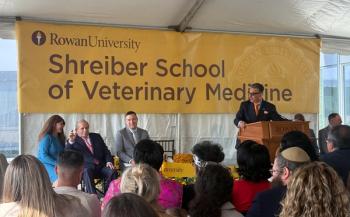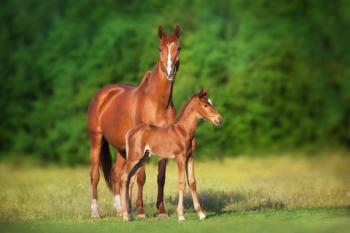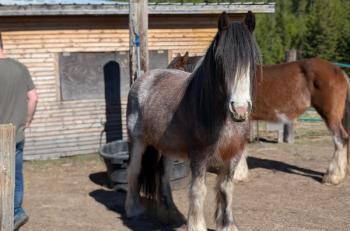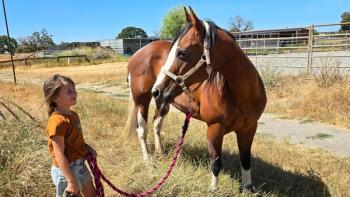
What's new in foal medicine (Proceedings)
In evaluating a foal with established pneumonia, how can you differentiate between R. equi pneumonia from those caused by other bacteria, while waiting culture results?
Rhodococcus equi
What 's new in treatment ?
Standard treatment is erythromycin + rifampin
More recently replaced with:
• -Azithromycin + rifampin
• -Clarithromycin + rifampin
Resistance to macrolides or rifampin is now being encountered
A study compared MIC data between 2000 and 2006:
• Over the 6 year period, the MIC of rifampin increased from 0.081 to 0.187 µg/ml
• MIC of erythromycin increased from 0.258 to 0.583 µg/ml
Another study from 2008 (Giguere et al, ACVIM 2008)
• 2 isolates were resistant to rifampin
• 17 isolates were resistant to all 3 macrolides and rifampin
Overall prevalence of resistance was 3.7 % of isolates
Survival rate of foals infected with resistant isolates was lower than of those with susceptible isolates
• 25 % vs. 70 %, P < 0.004
Resistant Isolates
We have found resistance in isolates from foals
Very concerning
Ask your micro lab to perform susceptibility testing of R. equi isolates
Not done routinely
Other Options
Other options for treatment?
Other macrolides ?
• Tilmicosin (Micotil) ?
In vitro studies show concentrations achieved in serum, pulmonary fluids and cells is below the MIC
Clinical experience also suggest that it is not effective
Tulathromycin (Draxxin)
Unknown efficacy at this point
In one study comparing tulathromycin with azithromycin in the treatment of undiagnosed pulmonary abscesses:
It took significantly longer for pulmonary abscesses to resolve
Seems fairly safe, but high rate of self-limiting diarrhea in 30 % and IM swelling in 32 %.
Requires further study; cannot be recommended at this time
Doxycycline
Effective: 10 mg/kg q 12 h PO achieves serum and tissue concentrations > MIC of R. equi
It shows synergism with rifampin
Clinical experience suggests it is effective in treating foals with R. equi
Clinically the response appears slower as compared to response to macrolide + rifampin
Good option for macrolide-resistant strains and for foals that have adverse reactions to macrolides
Controversies
Is R. equi plasma protective?
7 published studies
• 5 show improvement
o 2 were natural infections on farms
o 3 were experimental infections
• 2 showed no difference in incidence of pneumonia
o Both on farm setting
o One showed reduced incidence of disease 19.1 vs. 30 %, but it was not statistically difference
Controversies
• Prophylaxis with antibiotics?
• One study showed benefit of azithromycin for 2 weeks
• Concern over resistance to macrolides with indiscriminate use
• Not recommended
Differentiating R. equi foals
In evaluating a foal with established pneumonia, how can you differentiate between R. equi pneumonia from those caused by other bacteria, while waiting culture results?
We recently performed a study comparing these:
Vet J 2009
• Highly suggestive of R. equi:
o White cell counts >20,000cells/µL (86% specificity)
o Fibrinogen concentrations >700mg/dL (92% specificity),
o Radiological evidence of thoracic abscessation (85% specificity)
o Gram-positive coccobacilli in tracheal aspirates (91% specificity)
Extrapulmonary Disorders with R. equi
Reuss et al JAVMA: 2009
74 % of foals with R. equi had extrapulmonary involvement
• Most common forms:
o Diarrhea 33 %
o Immune-mediated polysynovitis 25 %
o Ulcerative enterocolitis 21 %
o Intra-abdominal abscess 17 %
o Uveitis 11 %
o Pyogranulomatous hepatitis 11 %
o Septic synovitis 9 %
o Bacteremia 7%
Extrapulmonary Disorders
Survival was higher among foals without these disorders
• 82 % vs. 43 % survival
• These foals with extrapulmonary forms were also sicker foals
o Sick for longer time prior to admission
o Higher white count and neutrophil count
o More had been previously examined and referred
Update on Lawsonia intracellularis
Agent of Equine Proliferative Enteropathy
Syndrome of hypoproteinemia, weight loss, lethargy, diarrhea
Pot belly appearance, poor doer
2 mo – yearling (most 3-7 mo of age)
Transmission is thought to occur by the fecal-oral route
Unknown definitive host; wildlife and domestic animals have been proposed
Found in feces of striped skunks, followed by Virginian opossums, jackrabbits, and coyote Pusterla, 2008
Disease occurs as sporadic cases and outbreaks
Lawsonia intracellularis infections
Clinical signs:
lethargy, weight loss, diarrhea, poor hair coat, pot belly, and edema, fever
Mild cases may be difficult to diagnose
Poor doer, daily weight gain reduced, low serum protein
Crypt cell proliferation and abscesses
Diagnosis
Fecal PCR
Serology > 1:30 – U of Minnesota
Both should be run simultaneously
Neither is highly sensitive
Abdominal US - very thick small intestine
Look for concurrent diseases
Parasites, Pneumonia
Treatment Options:
• Macrolide
o Azithromycin: 10 mg/kg PO, q 24 h x 5 days, then q 48 h
o Clarithromycin: 7.5 mg/kg PO, q 12 h
o +/- rifampin 5 mg/kg PO, q 12 h
Tetracycline group:
• Oxytetracycline: 6 mg/kg IV, q 12-24 h
• Doxycycline: 10 mg/kg PO, q 12 h
• Chloramphenicol:
o 40-50 mg/kg PO, q 6-8 h
Treatment
If the horse is very sick (not eating, lethargic, fevers):
1. Start with IV oxytetracycline for 1-3 d, then switch to doxycycline orally
2. Then continue with doxycycline for 2 weeks
Monitor creatinine closely while on tetracycline
• Can develop renal failure
• If not that sick (still eating, stable vitals)
• Use doxycycline from the start
• 10 mg/kg PO q 12 h
• Supportive and nursing care
Lawsonia intracellularis
• Survival is high with treatment: 82-93 %
• Long term follow up – yearlings in KY have sold for less money, however they suffer no apparent long term effects
• Race earnings are no different
Diarrhea in Foals
New Findings
Retrospective Analysis of Diarrhea in Foals
University of Florida, 2009: Frederick, 2009 JVIM
233 cases
An agent was identified in 55 % of foals
• Rotavirus 20 %
• Clostridium perfringens 18 %
• Salmonella 12 %
• Parasites 7 %
• Clostridium difficile 5 %
• Coronavirus 1 %
• Cryptosporidium spp 1 %
• Parasites (n=16):
o Roundworms (P. equorum); n=10
o Strongyles (n=6)
o Giardia (n=3)
o Trichostrongylus (n=1)
o S. westeri (n=1)
• 87 % survived
Survival did not vary with infectious agent
Nonsurvivors: Higher heart rate, PCV, BUN, creatinine
Blood cultures were positive in 49 % of foals
75 % of isolates were Gram negative; 25 % Gram positive
Most common
E coli (36 %)
Enterococcus spp (11 %)
Salmonella cultured in 6 %
Clostridium cultured in 3 %
This demonstrates the importance of covering enteritic foals with systemic antibiotics
Fibrinogen: An Indicator of Osteomyelitis
Fibrinogen and Osteomyelitis
Newquist 2009, JAVMA
Basis for study: Foals with OM of the physis or epiphysis are difficult to detect if they do not have concurrent joint involvement
These foals do not have swollen joints
Owners often believe the lameness is due to trauma
• Compared 4 groups: Foals were 1-119 days old
o Foals with OM (n=17)
o Foals with septic arthritis that did not have OM (n=17)
o Foals with pneumonia (n=20)
o Foals with no infection (angular limb deformities) (n=22)
Fibrinogen
• Results
o OM was significantly associated with a fibrinogen ≥ 900 mg/dl
o The Positive Predictive Value of fibrinogen ≥ 900 mg/dl in detecting OM was 84.2 %
o Fibrinogen ≥ 900 was associated with not having OM
o The Negative Predictive Value was 98.3 %
o Fibrinogen 500-800 was significantly associated with having pneumonia or septic arthritis without OM
o Fibrinogen 200-400 was significantly associated with lack of infection
• Mortality:
o 11/17 (65 %)* of foals with OM were euthanized
o 7/17 (41 %)* of foals with septic arthritis
o 2/20 (10 %) of foals with pneumonia
o 0 of foals with angular limb deformities
o No significant difference between OM and septic arthritis
Conclusions
1. Suspect OM in a lame foal with fibrinogen = 900 mg/dl
2. Fibrinogen concentration of 500-800 were associated with arthritis or pneumonia, but should not be used as a definitive diagnostic test as PPV is low
3. These rules don't apply to foals with R. equi, as fibrinogen is quite high in those foals even without OM
New Studies on Altrenogest (Regumate)
Study 1
Effects of altrenogest treatment of mares in late pregnancy on parturition and on neonatal viability of their foals.
Exp Clin Endocrinol Diabetes. 2008 Jul;116(7):423-8. Neuhauser S, et al.
Study 1: Altrenogest
0.088 mg/kg daily altrenogest administered during late gestation (d 280) until parturition to 6 mares, with 7 control mares
Cross over design, over 2 years
Administered altrenogest until foaled
Altrenogest
Results
o Gestational length tended to be shorter
o 2nd stage labor was prolonged (P < 0.05)
o Foals in the altrenogest group had a lower RR during the first 30 min
o Higher pH and BE
o Significantly more neonatal problems (3/6)
Study 1: Neonatal problems
• 2/6 altrenogest foals died :
o 1 due to dystocia
o 1 died 30 min post-birth, due to respiratory depression
• 1/6 required oxygen insufflation at 30 min post-birth
• None of control foals had these problems
Study 2: Altrenogest
Effect of altrenogest-treatment of mares in late gestation on adrenocortical function, blood count and plasma electrolytes in their foals.
Equine Vet J. 2009 Jul;41(6):572-7., Neuhauser S, et al.
Study 2: Altrenogest
Same mares as previous study
Treatment group: Double dose altrenogest from d 280 on ; Control group
Evaluated CBC, electrolytes and ACTH stimulation response
Study 2: Results
Altrenogest group foals had a lower NEUTROPHIL:LYMPHOCYTE ratio, consistent with immaturity
Plasma cortisol was higher
No differences in ACTH stim except at 15 min
Plasma potassium and calcium were lower
Conclusions
Altrenogest treatment of pregnant mares prolonged labor, did not lengthen gestation
Reduced NEUTROPHIL:LYMPHOCYTE ratio consistent with tendency for shorter gestation, and suggests immaturity or immunomodulatory effect of altrenogest
2/6 foals died and 1/6 required oxygen in the altrenogest group, associated with prolonged labor
Questions routine use of altrenogest!
Parasite Resistance
Roundworms
Last few years have documented resistance to:
• Ivermectin or Pyrantel pamoate
Pinworms (Oxyuris equi)
Recent paper documented resistance to ivermectin also
Newsletter
From exam room tips to practice management insights, get trusted veterinary news delivered straight to your inbox—subscribe to dvm360.






